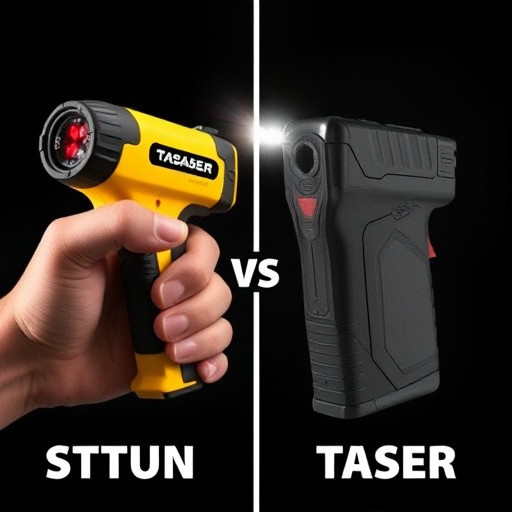The article explores the operational differences between stun guns and tasers, two non-lethal self-defense tools. Stun guns deliver high voltage, low amperage shocks through metal probes, while tasers use two small probes to disrupt muscle control with higher-amplitude pulses. Warranty coverage varies significantly: stun guns offer limited 1-3 year warranties focusing on defects, whereas tasers come with lifetime warranties covering both mechanical functionality and performance, sometimes even specific deployment scenarios. Understanding these distinct mechanisms and warranty policies is crucial when choosing between the two tools, with heavy users potentially benefiting most from taser warranties. Legal considerations and regional regulations should also guide selection.
“Uncover the distinct features of stun guns and tasers, two powerful self-defense tools, in this comprehensive guide. Understanding their unique mechanisms is key to making an informed choice. This article dives into the core differences, particularly their warranties, to equip you with vital knowledge. From coverage details to hidden clauses, we simplify the process. Additionally, we debunk myths, weigh pros and cons, and offer insights to help you decide between these popular personal defense devices, focusing on the critical aspect: the difference between stun gun and taser warranty.”
Understanding Stun Guns and Tasers: A Basic Overview
Stun guns and tasers are both non-lethal self-defense tools that use electric current to incapacitate an assailant, but they operate differently. A stun gun delivers a high voltage, low amperage electrical charge through metal probes into the target, causing temporary muscle paralysis and disorientation. In contrast, a taser fires two small probes connected to wires, which then deliver a higher-amplitude, shorter duration electrical pulse designed to disrupt an individual’s neuromuscular system, resulting in a loss of balance and control.
Understanding these basic differences is crucial when considering the warranty aspects. Stun gun warranties often cover defects in materials or craftsmanship, but may not extend to the effectiveness of the device against any target due to varying physical attributes. On the other hand, taser warranties typically include both mechanical functionality and performance, with some manufacturers offering coverage for specific scenarios where the taser might not deploy as expected, emphasizing the difference between stun guns and tasers beyond their intended use.
Warranty Coverage: Key Differences
When comparing a stun gun and a Taser, one of the critical factors to consider is their warranty coverage. Both types of personal defense devices offer protection against unexpected malfunctions, but the specifics differ significantly. Stun guns typically come with a limited warranty that covers manufacturing defects for a specific period, usually ranging from 1 to 3 years. This means if your stun gun fails due to a defect within this period, you may be eligible for repair or replacement.
In contrast, Tasers often boast more comprehensive warranties. Many reputable Taser models offer lifetime warranty coverage on their devices. This extensive warranty not only includes manufacturing defects but also accidental damage, such as drops or exposure to extreme conditions. Additionally, some manufacturers provide separate warranties for the device’s electrical components and the battery, ensuring that every aspect of the Taser is covered over its lifespan. These differences highlight how each brand prioritizes customer satisfaction and product reliability in the competitive market of personal defense equipment.
Factors to Consider When Choosing Between the Two
When choosing between a stun gun and a Taser, several factors come into play. The primary distinction lies in their mechanism of action; stun guns use electrical current to disrupt muscle control, while Tasers employ two probes that deliver a targeted electric shock, temporarily neutralizing the target. This fundamental difference impacts not only their effectiveness but also safety considerations.
Another critical aspect is warranty coverage. Stun guns often come with more straightforward warranties, typically covering manufacturing defects for a specified period. In contrast, Tasers usually offer extended warranty options, sometimes including parts and labor for a longer duration. It’s essential to compare these warranties against your expected use case; heavy users might prefer the enhanced protection offered by Taser warranties. Additionally, understanding the legal implications in your region regarding the ownership and use of each device is vital before making a decision.
Common Myths and Misconceptions Debunked
Many potential buyers are confused by the terms “stun gun” and “taser,” often using them interchangeably, but there’s a significant difference between the two non-lethal self-defense devices. A common misconception is that both emit an electric current of equal intensity; however, tasers use a specialized electrical pulse to disrupt muscle control, while stun guns deliver a direct electric shock. Tasers are designed to incapacitate from a distance, making them popular with law enforcement, whereas stun guns are typically used for close-range personal protection.
Another myth is that stun guns are always more powerful than tasers. In reality, the effectiveness of either device depends on various factors such as voltage, current, pulse width, and delivery method. Some high-quality tasers can deliver powerful jolts comparable to many stun guns. Additionally, while both come with warranties, these vary greatly; stun gun warranties often cover defects for a limited period, whereas taser manufacturers typically offer more comprehensive coverage, ensuring peace of mind for the user.
